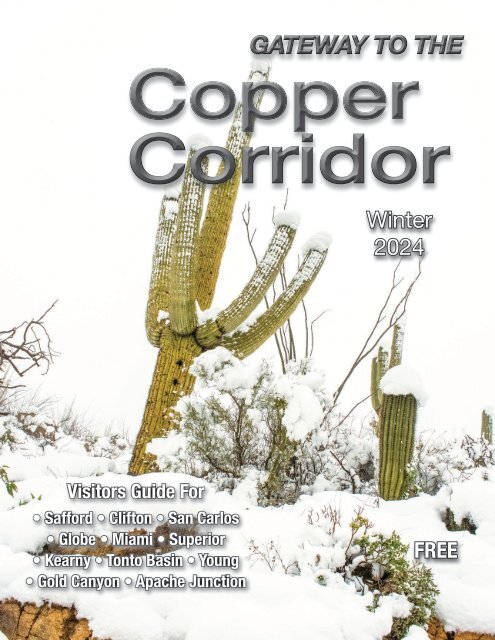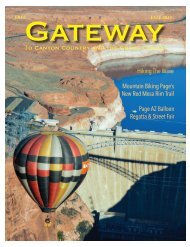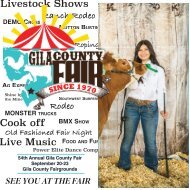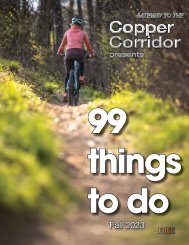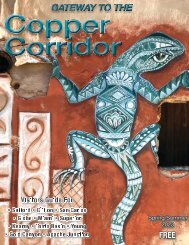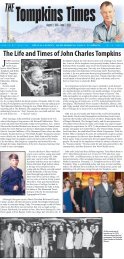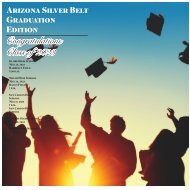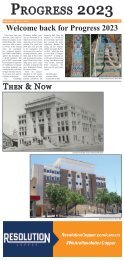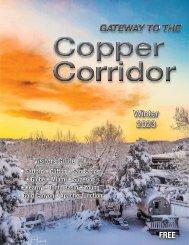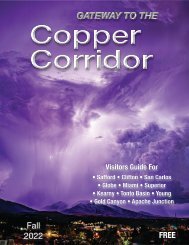Create successful ePaper yourself
Turn your PDF publications into a flip-book with our unique Google optimized e-Paper software.
GATEWAY TO THE<br />
<strong>Corridor</strong><br />
<strong>Winter</strong><br />
<strong>2024</strong><br />
Visitors Guide For<br />
Safford • Clifton • San Carlos<br />
• Globe • Miami • Superior<br />
• Kearny • Tonto Basin • Young<br />
• Gold Canyon • Apache Junction<br />
FREE
2<br />
<strong>Gateway</strong> to the <strong>Copper</strong> <strong>Corridor</strong> <strong>Winter</strong> <strong>2024</strong>
Table of Contents<br />
Welcome to the <strong>Winter</strong> <strong>2024</strong><br />
Edition of <strong>Gateway</strong><br />
Let’s go to Clifton, Arizona ................................................... 4<br />
Ranching couple sees Scots cattle prosper in Arizona........... 6<br />
Map: <strong>Gateway</strong> to the <strong>Copper</strong> <strong>Corridor</strong> .......................... 12-13<br />
Topo Joes shuttle service for mountain bikers .................... 16<br />
Arizona Fan Fest celebrates pop culture ............................ 19<br />
Miami Loco Arts Festival <strong>2024</strong> .......................................... 20<br />
San Carlos Apache Culture Center Museum ...................... 21<br />
Apache Leap Mining Festival ............................................ 22<br />
<strong>Gateway</strong> Staff<br />
To advertise in the <strong>Gateway</strong> to the<br />
<strong>Copper</strong> <strong>Corridor</strong>, contact:<br />
~Publisher Mike Caywood<br />
mcaywood@silverbelt.com<br />
~Sales Representative, Kathy Riley<br />
kriley@silverbelt.com<br />
~Editorial, Douglas Long, David Sowders,<br />
dlong@silverbelt.com; dsowders@silverbelt.com<br />
Cover photo:<br />
Cover photo was taken by Tina Nixon<br />
Arizona Silver Belt<br />
PO Box 31<br />
298 N. Pine St.<br />
Globe, AZ 85502<br />
928-425-7121<br />
www.silverbelt.com<br />
<strong>Copper</strong> Country<br />
News<br />
PO Box 1692<br />
298 N. Pine St.<br />
Globe, AZ 85502<br />
928-425-0355<br />
www.coppercountrynews.com<br />
<strong>Gateway</strong> to the <strong>Copper</strong> <strong>Corridor</strong> <strong>Winter</strong> <strong>2024</strong> 3
Let’s go to Clifton, Arizona<br />
Located on the<br />
beautiful San<br />
Francisco River,<br />
tucked into a rugged<br />
mountain canyon, Clifton,<br />
Arizona, offers a wide variety<br />
of history, recreation,<br />
attractions, watchable wildlife<br />
and raw beauty. Some<br />
would say Clifton is magical.<br />
It’s like stepping back<br />
in time.<br />
Founded in 1873, the<br />
town was named after Henry<br />
Clifton, an early pioneer.<br />
Others argue that the town<br />
was a contraction of “Cliff-<br />
Town,” so aptly described.<br />
It was the former mining<br />
center of Greenlee County.<br />
Entering Clifton, you’ll<br />
see the remains of an old<br />
smelter. Continuing your<br />
drive, you will see the historic<br />
train station, which<br />
houses the new addition of<br />
the Art Depot and the historical<br />
Clifton Visitors Center.<br />
This massive structure was<br />
deeded to the city by the<br />
Southern Pacific Railway.<br />
Daily, sometimes many<br />
times a day, you will see<br />
and be stopped at railroad<br />
crossings watching the Eastern<br />
Arizona Railway and<br />
the Freeport McMoran train<br />
transporting needed sulfuric<br />
acid to the Morenci Mine.<br />
Beyond the Visitors Center,<br />
on the left, you will find<br />
the old Clifton Jail, a rock<br />
bastille blasted out of the<br />
side of the mountain built<br />
in 1878. Here, the infamous<br />
were incarcerated. It is one<br />
of the state’s famous jails.<br />
Adjacent to the jail is the old<br />
<strong>Copper</strong>head Locomotive<br />
No. 8, built in 1897. Farther<br />
on, you’ll find Chase<br />
Creek, once the epicenter<br />
of the town. In 1908, Chase<br />
Creek boomed for over 20<br />
years. However, because of<br />
raging floods, this part of<br />
town was almost washed<br />
away. Because of many<br />
people loving this wonderful<br />
area, it now showcases<br />
art galleries, antique shops,<br />
a book and toy store, an<br />
apothecary with many different<br />
local gifts available a<br />
beautiful church, and a historical<br />
museum.<br />
With all the history, expand<br />
your visit to include<br />
photo ops of the watchable<br />
wildlife. If you are lucky,<br />
you may come across some<br />
of our magnificent big horn<br />
sheep, often seen lazily<br />
grazing on the side of the<br />
road or train station lawn,<br />
and many more activities<br />
, including rock hounding<br />
and hiking. Did I mention<br />
bird watching? There are<br />
four trails within the area.<br />
Contact the CLIFTON<br />
VISITORS CENTER (928-<br />
865-3313 or P.O. Box 1415,<br />
Clifton AZ 85533) for more<br />
info. We will gladly help<br />
you plan your getaway for<br />
an unforgettable experience.<br />
Nestled high in the<br />
Pellocinno mountains, with the San Francisco<br />
river running by, you will find the North Clifton RV park. With 59 spaces,<br />
club house, Wi-Fi, showers, laundry, a new library walk, new playground equipment and<br />
picnic pavillions, pet friendly / pet area and beautiful scenery anywhere you look.<br />
Recreational activities abound. Birding trails, hiking, rock hounding, biking, river walk, watchable wildlife and if you are<br />
lucky you will see our famous bighorn sheep grazing on the grass in the park.<br />
Our park is in a quaint, quiet area, yet still in walking distance of Chase Creek, our historical district. Clifton, Az offers<br />
the rare blend of history, architecture, romance and adventure all wrapped up in the splendor of an Old West mining town.<br />
928-292-0070<br />
4 <strong>Gateway</strong> to the <strong>Copper</strong> <strong>Corridor</strong> <strong>Winter</strong> <strong>2024</strong>
<strong>Gateway</strong> to the <strong>Copper</strong> <strong>Corridor</strong> <strong>Winter</strong> <strong>2024</strong><br />
5
Ranching couple<br />
sees Scots cattle<br />
prosper in Arizona<br />
Story by David Sowders<br />
Photos by Douglas Long<br />
Jim and Carol Ptak’s Gryphon Ranch, in<br />
the hilly El Capitan area south of Globe,<br />
Arizona, got its start in western Washington<br />
state 18 years ago.<br />
“We only had 100 acres; it was mainly a hay<br />
farm,” said Carol Ptak. It was after expanding<br />
that hay farm, doubling it in size, that the Ptaks<br />
were introduced to Scottish Highland cattle.<br />
“The next year, we went to harvest again, and<br />
we still had all that bad hay in the barn,” said<br />
Carol. “At that point you have a choice: Either<br />
pull it all out of the barn and burn it, or find<br />
something to eat it.”<br />
A friend suggested the “stupid-proof” Highland<br />
breed, so called because “you can be pretty<br />
stupid and still do well with them, because<br />
they’re so durable and hardy.”<br />
The Ptaks took that suggestion, buying a pair<br />
of Highland steers. Their intent was to eat one<br />
and sell the other. Discovering that it takes the<br />
breed three years to grow up, they purchased<br />
two more steers – and the couple’s venture into<br />
ranching would take off from there.<br />
“We had a neighbor down the road who had<br />
Highlands and he had taken ill, so we ended<br />
up boarding his breeding herd for six months,”<br />
Carol said. “He paid us in cow-calf pairs, and<br />
next thing you know we were off and running.”<br />
On an early January day, stretches of the road<br />
to Gryphon Ranch were covered in snow. As<br />
she drove a side-by-side toward the ranch, Carol<br />
said the road followed the original 19th century<br />
stagecoach route from Tucson to Globe.<br />
The move<br />
The Gryphon Ranch – Arizona’s sole commercial<br />
breeder of Highland cattle – has been<br />
at El Capitan for 10 years. It has always been a<br />
two-person “mom and pop” operation.<br />
The Ptaks came to Arizona for the same<br />
6 <strong>Gateway</strong> to the <strong>Copper</strong> <strong>Corridor</strong> <strong>Winter</strong> <strong>2024</strong>
eason many people leave their home<br />
states: health, in this case Jim Ptak’s severe<br />
migraines.<br />
“We discovered, coincidentally, that he<br />
was well, or 90% well, here. So we picked<br />
up the operation and moved,” said Carol.<br />
The spread had some history as a ranch<br />
before they arrived. A former ice house and<br />
the ruins of an old slaughterhouse stand on<br />
the grounds where the Ptaks’ cattle roam.<br />
The property was once owned by Charles<br />
“Bud” Clark and his wife Lenora, then by<br />
Paul “Dupper” Corso, who ran Mid-State<br />
Pipe and Supply in Globe. Corso later sold<br />
the land to developers from the Valley – “just<br />
as property crashed in 2008,” Carol said.<br />
“Then we bought it from them and restored<br />
it back to ranching operations.”<br />
Jim and Carol brought 19 head of Highlands<br />
down to Arizona.<br />
“We butchered everything we could, loaded<br />
everything else into two trailers, and off<br />
we went,” Carol said. They had the help, she<br />
recalled, of some Mennonite farmers.<br />
“It was interesting because the day before,<br />
they had tried to load an Angus bull for about<br />
six hours, and here they had 19 head of Highlands<br />
to put in two trailers – and we had them<br />
all loaded in 27 minutes. They’re very calm;<br />
they’re very easy cattle to work with,” she<br />
said.<br />
“When we first moved here, a lot of people<br />
thought we were crazy, bringing these<br />
fuzzy cows; they called them the hippie<br />
cows. ‘They’re never going to survive here<br />
with their long hair,’ they said. Now people<br />
come to us to buy animals for breeding because<br />
they’re adapted to this climate.”<br />
See RANCH, page 8<br />
<strong>Gateway</strong> to the <strong>Copper</strong> <strong>Corridor</strong> <strong>Winter</strong> <strong>2024</strong> 7
RANCH from page 7<br />
What are<br />
Highlands cattle?<br />
The name Highlands reflects<br />
the breed’s origin in<br />
that region of Scotland.<br />
“They were bred to be<br />
able to withstand incredibly<br />
difficult conditions,”<br />
Carol said.<br />
“For a while the Scots<br />
thought they didn’t have to<br />
feed the Highlands at all,<br />
but the reality is the Highlands<br />
were eating everything<br />
from the lichens to<br />
the trees. They’ll eat anything<br />
a goat will eat.<br />
“The Highland hide is<br />
twice the thickness of an<br />
Angus. I can pick up an<br />
Angus hide, no problem,<br />
and throw it around all day<br />
long. I cannot pick up a<br />
Highland hide; it takes two<br />
of us. They’re that much<br />
heavier.”<br />
Highlands cattle, she<br />
said, would live in the<br />
house with Scottish families<br />
– people upstairs and<br />
cattle downstairs.<br />
“They were used for<br />
milk, for fiber – they would<br />
The fold – a group of Highland cattle is called a fold, not a<br />
herd – usually comes in to feed around 4 o’clock.<br />
The road through the Gryphon Ranch follows the original<br />
19th century stagecoach route from Tucson to Globe.<br />
take the hair and spin it into<br />
fiber – and for meat,” she<br />
said.<br />
She said Highland meat<br />
was very lean and healthy,<br />
lower in cholesterol and<br />
higher in protein as well as<br />
omega-3 and omega-6 fatty<br />
acids. The breed comes<br />
in seven different colors:<br />
white, silver, red, dun, brindle,<br />
yellow and black – and<br />
the Ptaks own one dun bull<br />
that can produce all seven.<br />
The black variety, called<br />
kyloes, originated along<br />
Scotland’s western coast,<br />
where cowherds would<br />
swim them from pasture to<br />
pasture among the islands.<br />
Carol added that there is no<br />
such thing as a “miniature<br />
Highland,” despite online<br />
claims; adult Highlands<br />
cattle grow to around 1,000<br />
pounds.<br />
Each of their cattle has a<br />
name.<br />
“When we started – we<br />
thought this was going to<br />
be enough – we named<br />
them in the order of the<br />
Greek alphabet,” she said.<br />
Of that original series, two<br />
cows named Delta and Epsilon<br />
are still on the ranch.<br />
After that, the Ptaks went<br />
through gems and minerals<br />
from A to Z, the Greek<br />
gods and flowers. Their<br />
latest series is named after<br />
trees; the newest addition<br />
to the fold is Holly, born on<br />
Christmas Day 2023.<br />
“So far, knock on wood,<br />
we’ve never lost an animal<br />
to predation, because<br />
they can take care of themselves,”<br />
she said. “All<br />
Highlands have horns; they<br />
know where their horns<br />
are and exactly how to use<br />
them. If a predator goes<br />
after one of the babies and<br />
the baby starts squalling,<br />
then you’ll see a bunch of<br />
adults running real fast.”<br />
The Code of the West<br />
On Gila County’s official<br />
website, a page titled<br />
“The Code of the West”<br />
outlines the challenges and<br />
potential drawbacks of rural<br />
life – from lack of services<br />
to extreme weather<br />
to animals. “Since the rural<br />
West will not change to accommodate<br />
your lifestyle<br />
or expectations, you should<br />
be prepared to adapt accordingly,”<br />
it reads in part.<br />
Carol expressed it this way:<br />
“Congratulations, you<br />
bought property out here;<br />
don’t expect to see many<br />
services because you’re<br />
not.”<br />
“Living off-grid is an<br />
interesting phenomenon,”<br />
she added. “We don’t have<br />
a lot of things people take<br />
for granted. We’re totally<br />
out here on our own.”<br />
Though the Gryphon<br />
Ranch employs solar power,<br />
there is no electric power,<br />
water, sewer or mail/<br />
package delivery, and<br />
stores are 14 miles away.<br />
“We do everything everybody<br />
else does; it’s just<br />
that we do it a little differently.<br />
Our internet comes<br />
by satellite, our power is<br />
solar, our water comes<br />
from a spring, we can’t<br />
use electrical fencing,” she<br />
said. “We had to replace<br />
water lines five times because<br />
they kept getting torn<br />
out by the next flood.”<br />
The Ptaks finally hired<br />
8 <strong>Gateway</strong> to the <strong>Copper</strong> <strong>Corridor</strong> <strong>Winter</strong> <strong>2024</strong>
a local company, Dixon<br />
Rock and Materials, to<br />
bury their water lines 8 feet<br />
deep. An added benefit to<br />
this was fewer frozen water<br />
lines, which Jim Ptak had<br />
had to fight in wintertime.<br />
(For anyone interested in<br />
further reading, the county’s<br />
“Code of the West”<br />
page, which begins with<br />
a reference to no less than<br />
Western author Zane Grey,<br />
can be seen at https://www.<br />
gilacountyaz.gov/government/community_development/the_code_of_<br />
the_west.php. Its text was<br />
adapted from “The Code of<br />
the West … The Realities<br />
of Rural Living,” written<br />
by former Larimer County<br />
(Colorado) Commissioner<br />
John Clarke around 1997.)<br />
Fire and flood<br />
Driving down the road<br />
to their property, Carol<br />
said ranching was not for<br />
the faint of heart – something<br />
that rings even more<br />
true when natural disaster<br />
strikes, as it did in 2021.<br />
Carol and Jim Ptak at their off-the-grid house on Gryphon Ranch.<br />
Gryphon Ranch’s business,<br />
she said, expanded<br />
greatly when COVID-19<br />
hit. On seeing no meat<br />
in grocery stores, people<br />
sought healthy options<br />
from a local source and the<br />
ranch sold out quickly.<br />
“We couldn’t expand<br />
our Highland offering fast<br />
enough for what the market<br />
was demanding,” she said.<br />
So the ranch began buying<br />
purebred Angus from a<br />
rancher in Klondyke, Arizona.<br />
“Angus finish for beef<br />
much faster, at 15-18<br />
months old; it takes 40<br />
months to get a Highland<br />
to finish,” she said. “The<br />
last few years have been<br />
very busy for us and very<br />
good – as a ranch. It’s been<br />
very good from a sales perspective.”<br />
But then there was the<br />
summer of 2021. On Gryphon<br />
Ranch, the devastating<br />
Mescal and Telegraph<br />
Fires came together; Carol<br />
called it the crossroads.<br />
“The fires burned<br />
out all of our perimeter<br />
fencing,” she said. “We<br />
were evacuated, and<br />
had almost a week to<br />
look at each other and<br />
say, ‘What are we going<br />
to do? Are we going to<br />
come back and rebuild,<br />
See RANCH, page 10<br />
Gryphon Ranch, located in the hilly El Capitan area south of Globe, is Arizona’s sole commercial breeder of Highland cattle.<br />
<strong>Gateway</strong> to the <strong>Copper</strong> <strong>Corridor</strong> <strong>Winter</strong> <strong>2024</strong> 9
RANCH from page 9<br />
or sell it and go?’”<br />
Not all was lost, though: Firefighters<br />
were able to save the Ptaks’ house,<br />
barn, other buildings and, importantly,<br />
the cattle.<br />
“So we decided to rebuild, and<br />
it’s taken our life savings to do that.<br />
Unfortunately, we didn’t know the<br />
floods were coming,” Carol said.<br />
“We took 22 floods for the summer<br />
of 2021, starting on July 3. The<br />
last big one came through Christmas<br />
Eve, and it tore out all of our internal<br />
fencing, all of our water lines, and all<br />
of our cattle handling facilities. So on<br />
top of losing all of our fences to the<br />
fires, then we lost all of our internal<br />
stuff and our topsoil to the floods. It’s<br />
been a very difficult, long trek back –<br />
from being totally dysfunctional and<br />
wondering what we were going to do<br />
with all these animals. Now we’re<br />
pretty functional and are trying to get<br />
back to full operations, but the ranch<br />
still has not recovered the forage. We<br />
lost about 90% of our forage, so that’s<br />
been especially difficult. We’ve had<br />
to augment with more hay than what<br />
we did previously.”<br />
She added that the plants that have<br />
grown back are toxic to cattle. Compounding<br />
their troubles, she said,<br />
is that insurance does not cover the<br />
flood damage.<br />
Range tech<br />
On the Ptaks’ dining room table sat<br />
a bit of more modern technology, a<br />
GPS tracker ear tag with a solar panel.<br />
“It keeps track of where the animal<br />
is, so I have an app on my phone that<br />
tells me by number – the tag number<br />
is assigned to the cow or steer, and<br />
so I know where they’re at, I know<br />
where they’ve been traveling and I<br />
know where to go find them,” Carol<br />
said.<br />
“The ranchers who have tens of<br />
thousands of acres, the cowboys<br />
spend days and days riding horses<br />
looking for cows. So we’ve been trying<br />
to use the more modern technology<br />
of GPS tags on the cattle.”<br />
The tag, she added, was “not quite<br />
ready for prime time yet, because<br />
with that single hole they tend to tear<br />
out of their ears.”<br />
The Ptaks are also seeking to improve<br />
their stock – “take our cattle<br />
to the next level,” as Carol put it –<br />
through artificial insemination, using<br />
semen from a Highland bull in the<br />
home country of Scotland.<br />
“We’re going to be breeding 10 of<br />
our cows,” she added. Helping them<br />
with the project, she said, was fellow<br />
Gila County rancher Tyler DalMolin.<br />
She said they use as much of an<br />
animal as possible, adding that hides<br />
and heads are donated to the Apache<br />
tribe, who use the hides for latigos,<br />
drums or moccasins. As for the<br />
heads, she said, “We’ve got friends<br />
who are missionaries out in San Carlos.<br />
They clean the heads up, then the<br />
Apaches help decorate them and they<br />
sell them. The proceeds go to their<br />
feeding ministry out on the San Carlos<br />
reservation.”<br />
In mid-January, Carol flew to Denver<br />
for the National Western Stock<br />
Show, where two Gryphon Ranch<br />
bulls were being exhibited.<br />
“We’re coming out of little Globe<br />
and we’re now going to show up on<br />
the national scene and see what the<br />
national breeders think,” she said.<br />
“The initial feedback has been very<br />
positive, so we hope the boys do a<br />
good job up in Denver and win. The<br />
National Western is the most prestigious<br />
Highland event in the country,<br />
so we’re excited.”<br />
Emerald<br />
Gryphon Ranch, a grass-fed,<br />
grass-finished beef operation, spreads<br />
over 1,000 acres.<br />
“As we drove in, we probably<br />
passed 45 head of cattle that you<br />
didn’t see because they’re hiding in<br />
all those canyons and little draws,”<br />
said Carol.<br />
The Ptaks own 469 of those acres<br />
and lease the rest.<br />
“That makes us a very large ranch<br />
and a very small ranch at the same<br />
time. A typical Arizona ranch is tens<br />
of thousands of acres, but typically<br />
the rancher only owns deeded 40 or<br />
80 acres. So it gives us freedom that<br />
a typical rancher doesn’t have,” she<br />
said.<br />
“Ranchers are your best ecological<br />
care people. They’re going to<br />
take care of the environment better;<br />
they’re the original environmentalists.<br />
At the same time, if we didn’t<br />
ranch and if we didn’t eat the animal,<br />
they would be extinct. You can’t afford<br />
to feed 62 head of cattle; at least<br />
I know I can’t. By them fulfilling the<br />
mission of why God put them on the<br />
face of this Earth, we get to enjoy<br />
these beautiful animals.<br />
“The oldest cow that we retired<br />
was 19, which is very unusual for<br />
cattle. That was Emerald, who we<br />
brought down from Washington.”<br />
The fold – a group of Highland cattle<br />
is called a fold, not a herd – usually<br />
comes in to feed around 4 o’clock.<br />
“It’s like if you knew somebody<br />
was going to bake you warm chocolate<br />
chip cookies at 4 o’clock every<br />
day, where would you be at 4? Also,<br />
our ranch is the only water in the<br />
canyon, so they have to come in for<br />
that,” Carol said. “My husband and I<br />
enjoy a really high quality of life, because<br />
we look at the beauty of these<br />
animals every day.”<br />
10 <strong>Gateway</strong> to the <strong>Copper</strong> <strong>Corridor</strong> <strong>Winter</strong> <strong>2024</strong>
Family Dining<br />
Join us for quality time and quality food!<br />
Open:<br />
Thurs - Mon<br />
11am - 8pm<br />
To go orders -<br />
pickup and delivery<br />
La Casita Cafe<br />
Locally owned and operated<br />
928-425-8462<br />
470 N Broad St • Globe, AZ<br />
Good Food • Great Dining<br />
Since 1947<br />
Featuring Our<br />
“2 nd Friday” Lectures!<br />
Second Friday of each Month.<br />
Doors open at 6pm<br />
Come Visit<br />
The Past,<br />
Present & the<br />
Future!<br />
Exhibits Include:<br />
• New photographs on display from<br />
various local artists<br />
• Meeting rooms available<br />
• Slavic History Exhibit<br />
• Mining & Mineral Display<br />
• Ranching History<br />
• Native American Heritage Exhibit<br />
• Congressman Ed Pastor Exhibit<br />
• and so much more!<br />
150 N Plaza Circle, Miami, AZ | 928-473-3700<br />
This advertising is paid for by a grant from the Arizona Commission on the Arts.<br />
<strong>Gateway</strong> to the <strong>Copper</strong> <strong>Corridor</strong> <strong>Winter</strong> <strong>2024</strong><br />
Open:<br />
Wed-Sat 11am-2pm<br />
Closed Sun-Tue<br />
11
Queen Valley Golf Course<br />
Boyce Thompson Arboretum<br />
Superior Chamber of Commerce<br />
Bullion Plaza Museum<br />
Globe-Miami Chamber of Commerce<br />
Gila County Historical Museum<br />
Cobre Valley Center for the Arts<br />
Besh-Ba-Gowah Archaeological Park<br />
Round Mountain Hiking Park<br />
Old Dominion Park<br />
Roosevelt Lake & Visitor Center<br />
Superstition Mountain Museum<br />
Dolly Steamboat<br />
Tortilla Flat<br />
Apache Gold Casino & Resort<br />
San Carlos Rec. & Wildlife<br />
Mt. Graham Observatory<br />
Graham County Chamber<br />
Clifton AVIC Visitors Center
14 <strong>Gateway</strong> to the <strong>Copper</strong> <strong>Corridor</strong> <strong>Winter</strong> <strong>2024</strong>
<strong>Gateway</strong> to the <strong>Copper</strong> <strong>Corridor</strong> <strong>Winter</strong> <strong>2024</strong><br />
15
Topo Joes offers Pinal Mountain<br />
shuttle service for mountain bikers<br />
By Douglas Long<br />
Editor<br />
The Pinal Mountains<br />
just south of<br />
Globe are a haven<br />
for mountain biking, ranging<br />
from nearly 8,000 in<br />
altitude down to the high<br />
desert of 4,000 feet. The<br />
mountains are home to a<br />
wide variety of flora and<br />
fauna, including black<br />
bear, mule deer, bobcats<br />
and rattlesnakes.<br />
The severe terrain means<br />
that cyclists usually find<br />
themselves either pedaling<br />
up steep grades or flying<br />
downhill, with few options<br />
for flat, casual riding.<br />
For those who do not savor<br />
the prospects of struggling<br />
uphill for mile after<br />
mile to earn their downhill<br />
ride, Topo Joes bike shop<br />
in Globe offers a solution:<br />
a shuttle van that provides<br />
reliable transportation to<br />
higher elevations so mountain<br />
bikers can focus on the<br />
fun part of cycling – gravity-assisted<br />
downhill rides<br />
back into town.<br />
There are several options<br />
for the shuttle. Transport<br />
to higher points on<br />
the mountain – including<br />
access to Six Shooter Canyon<br />
Trail (TR-197), Telephone<br />
Trail (TR-192) and<br />
Kellner Canyon Trail (TR-<br />
242) – costs $30 per person<br />
with a bike, or $25 per person<br />
without a bike or with<br />
a Topo Joes rental bike.<br />
Douglas Long/<strong>Copper</strong> <strong>Corridor</strong><br />
The Pinal Mountains: great terrain for riding downhill on a<br />
mountain bike.<br />
There is a three-seat (or<br />
$90) minimum to schedule<br />
a shuttle, but big groups of<br />
six or more can ask about<br />
special rates. Reservations<br />
should be made at least 24<br />
hours before the desired<br />
shuttle time. The drive up<br />
to these trailheads takes<br />
about 1 hour.<br />
A shorter option is a<br />
drop-off at the junction<br />
of FR-157 and FR-651,<br />
which provides access to a<br />
fun, 6-mile, mostly downhill<br />
ride on the two-track<br />
FR-157 northward across<br />
the Pinal foothills to downtown<br />
Globe. The track is<br />
less steep and less technical<br />
than the trails higher<br />
up the mountain, making it<br />
a great ride for beginners.<br />
It’s also a good option<br />
when higher elevations<br />
are snowed in, or for those<br />
who are short on time (the<br />
ride can be done in well<br />
under 1 hour). The shuttle<br />
cost for this ride is $5 per<br />
person with a bike.<br />
Topo Joes staff advises<br />
those planning on using<br />
the shuttle service to be<br />
prepared for conditions on<br />
the mountain. Temperatures<br />
can be 20-40 degrees<br />
cooler than in town, with a<br />
greater chance for precipitation<br />
and higher winds,<br />
so appropriate clothing<br />
and gear should be worn<br />
for existing and potential<br />
weather conditions.<br />
Water is not available<br />
on the mountain and there<br />
is no trash service, so cyclists<br />
should plan on disposing<br />
of waste properly<br />
and following the “pack it<br />
in, pack it out” ethos. All<br />
trails on the mountain are<br />
multiuse and bidirectional.<br />
Horses and hikers have the<br />
right of way over bicycles.<br />
Above all, Topo Joes encourages<br />
cyclists to have<br />
fun on the trails. The shop<br />
is fully insured, licensed<br />
and permitted by the U.S.<br />
Forest Service to provide<br />
shuttle service.<br />
For more information<br />
on the shuttle and other<br />
services, including bicycle<br />
repairs and sales, contact<br />
Topo Joes by calling 928-<br />
351-6411, texting 928-<br />
961-2583 or visiting www.<br />
topojoes.com online. The<br />
shop is located at 465 N.<br />
Broad Street, Globe, Arizona.<br />
Hours are 10 a.m. –<br />
6 p.m. Wednesday through<br />
Saturday. They are closed<br />
Sunday through Tuesday.<br />
16 <strong>Gateway</strong> to the <strong>Copper</strong> <strong>Corridor</strong> <strong>Winter</strong> <strong>2024</strong>
YOUR HISTORY LIVES HERE.<br />
FIND YOUR BEGINNINGS IN GLOBE, ARIZONA.<br />
928.425.7385<br />
Tue-Sat: 11am - 2pm<br />
1330 N Broad St, Globe, AZ<br />
gilahistoricalmuseum.org<br />
<strong>Gateway</strong> to the <strong>Copper</strong> <strong>Corridor</strong> <strong>Winter</strong> <strong>2024</strong><br />
17
Experience the Ancient History of Arizona<br />
The Besh Ba Gowah Archaeological Park in Globe, AZ, provides a unique opportunity to explore the<br />
partially restored ruins of the ancient Salado culture of the southwest.<br />
The Museum houses a large collection of pottery and artifacts that provide visitors a fascinating glimpse at<br />
the lifestyle of the people who occupied the site from 1225 to 1400 CE.<br />
Hours of Operation: Regular 7 Days 9AM-4:30PM, Summer Wed.-Sun. 9AM-4:30PM<br />
928.425.0320 | 1324 Jesse Hayes Rd Globe, AZ 85501<br />
Find us online! https://www.globeaz.gov/besh-ba-gowah-archaeological-park-and-museum<br />
: Amanda Moors<br />
18 <strong>Gateway</strong> to the <strong>Copper</strong> <strong>Corridor</strong> <strong>Winter</strong> <strong>2024</strong>
Arizona Fan Fest celebrates pop culture<br />
Safford is the place,<br />
and spring is the<br />
time, for southeastern<br />
Arizona’s premier pop<br />
culture event – Arizona Fan<br />
Fest, a convention spotlighting<br />
comics, gaming<br />
and original art.<br />
This two-day event<br />
(Friday, April 5 – Saturday,<br />
April 6) features the<br />
finest comic creators and<br />
self-publishers, along with<br />
collectibles retailers and<br />
master crafters of everything<br />
from jewelry and<br />
clothing to wild, unique<br />
items for home and work.<br />
The highlight of Arizona<br />
Fan Fest is the Cosplay<br />
Contest, where everyone<br />
has the chance to become<br />
their favorite character. The<br />
contest includes a Premiere<br />
category for cosplay master<br />
crafters; the Premiere<br />
winner will go home with<br />
$1,000.<br />
Arizona Fan Fest will<br />
take place at the Graham<br />
County Fairgrounds in Safford,<br />
inside the Agriculture<br />
Building.<br />
Admission is just $5 per<br />
person per day, and the fairgrounds<br />
features plenty of<br />
free parking. For more information,<br />
email Arizona-<br />
FanFest@gmail.com or call<br />
928-322-5029.<br />
Fernando Shipley<br />
License: AZ-6735550<br />
1400 N Broad St<br />
Globe, AZ<br />
928-425-7656<br />
Apache Junction, AZ . (480) 827-9144<br />
www.dollysteamboat.com<br />
Golden Hills<br />
NURSERY & POULTRY STORE<br />
www.goldenhillsnurseryaz.com<br />
Mon - Sat 8a - 5p<br />
Sun 10a - 3p<br />
(928) 425-6004<br />
5444 E Golden Hills Rd. • Globe, AZ<br />
<strong>Gateway</strong> to the <strong>Copper</strong> <strong>Corridor</strong> <strong>Winter</strong> <strong>2024</strong><br />
Arizona’s<br />
World<br />
Class Cruise<br />
Come up and see Mike!<br />
With over 40 years<br />
experience, Mike can<br />
help you find just what<br />
you need to make<br />
your life beautiful.<br />
Skilled Nursing Home Health<br />
For more info contact<br />
Franceen Gregovich<br />
Patient Care Coordinator<br />
996 N. Broad St.<br />
Cell 928-812-4227<br />
Cami, Kandace, Kenia,<br />
Danielle and Natalie<br />
Office: 928-425-4444<br />
Toll Free: 800-457-0274<br />
905 E Ash St<br />
Globe, AZ 85501<br />
(across from Chalo’s)<br />
www.camilucero.com<br />
Cami Lucero<br />
State Farm Agent<br />
19
Miami Loco Arts Festival <strong>2024</strong><br />
Courtesy of Amanda Rae<br />
Butoh Sonics from Tempe is among the acts scheduled to<br />
perform at the <strong>2024</strong> Miami Loco Arts Festival.<br />
The Miami Loco Arts & Music Festival returns for the 12th<br />
time this spring with live music, art exhibits, poetry performances<br />
and more over three days from April 19 to 21.<br />
The Miami Loco Arts Festival is a free, all-inclusive art walk<br />
in downtown Miami, Arizona. It will include art exhibits, dozens<br />
of bands, poetry readings and other stage performances for<br />
all ages and tastes at various locations around town.<br />
The event will feature a street stage on Keystone Street with<br />
live music on Friday night until midnight, Saturday all day and<br />
at night until midnight, and all day Sunday. Other artists will<br />
also perform on multiple stages in local bars and other venues<br />
around town. There will also be performance art, a poetry<br />
procession, food trucks, and vendors selling crafts and goods<br />
throughout the event.<br />
Among the performers confirmed for the festival are Courtney<br />
Odom and The Rhythm Weaver (Miami local), Karyn Ann<br />
(Portland,Oregon), The Max Riley Band (Sacramento, California),<br />
Comperson (Tucson), Dutch Holly (Phoenix), Instagon<br />
(Miami local), Sunburnt Stone (Albuquerque, New Mexico),<br />
20ft Neon Jesus (Phoenix), Joe Feldman (Phoenix) and Butoh<br />
Sonics (Tempe). Many more acts will be announced.<br />
Phoenix artist James B. Hunt (aka NXOEED) will bring a<br />
new show of art to the Miami Art Works Gallery. There are also<br />
plans for other popup art installations and exhibits around town.<br />
For more information on the festival, email the Miami Arts<br />
Commission at miamilocoartsfestival@gmail.com, or contact<br />
Lob Instagon at 562-225-7115.<br />
The Miami Loco Festival is a project of the Miami Arts<br />
Commission (MAC), a 501(c)(3) nonprofit whose mission is<br />
to revitalize the Miami, Arizona, area through the arts.<br />
Courtesy of Amanda Rae<br />
Visitors get creative at the Miami Arts Commission table<br />
during the 2023 festival.<br />
20 <strong>Gateway</strong> to the <strong>Copper</strong> <strong>Corridor</strong> <strong>Winter</strong> <strong>2024</strong>
Preserving tradition while looking to the future<br />
By Douglas Long<br />
Editor<br />
In 2018, Peridot native<br />
Marlowe Cassadore<br />
took over as<br />
director of the San Carlos<br />
Apache Culture Center<br />
Museum. The museum<br />
had been founded in the<br />
late 1980s, as Cassadore<br />
explained, by a group of<br />
people who felt the need<br />
to preserve Apache culture<br />
and language.<br />
“They thought one of<br />
the best ways to do it was<br />
to have a museum, because<br />
there was this transition toward<br />
younger Apache not<br />
understanding who they<br />
are, what their culture is and<br />
their language,” he said.<br />
Cassadore was born and<br />
raised in the Peridot area,<br />
where the museum is now<br />
located along Highway 70.<br />
When he started kindergarten<br />
at Peridot Lutheran<br />
Mission School, he didn’t<br />
speak a word of English.<br />
He came from a family rich<br />
in Apache culture and tradition.<br />
He later graduated<br />
from the University of Arizona,<br />
and then lived and<br />
worked for a time in California<br />
before returning to<br />
San Carlos.<br />
When Cassadore took<br />
over as director five years<br />
ago, the museum collection<br />
already included a range of<br />
displays on Apache baskets,<br />
pottery, clothing, jewelry,<br />
tools, foods, traditional<br />
games and ceremonies, and<br />
more. Cassadore immediately<br />
stated his intention to<br />
apply knowledge obtained<br />
from Apache Elders to expand<br />
the museum, add new<br />
activities and even find a<br />
new location.<br />
“This museum was started<br />
from scratch. Before, this<br />
building was a place where<br />
people got their cars fixed,<br />
and then it was a small café.<br />
It eventually became a museum,”<br />
Cassadore said. “I<br />
think it was supposed to be<br />
temporary, this building.<br />
It’s an old building, and it’s<br />
not very suitable to protect<br />
and preserve some of the<br />
collection here, as far as climate<br />
control and storage.”<br />
Among Cassadore’s<br />
tasks as director is applying<br />
for grants for things like<br />
purchasing instruments to<br />
measure the moisture in the<br />
air and to help regulate the<br />
building’s temperature and<br />
humidity levels. He also<br />
hopes to secure funding<br />
for capacity building so he<br />
can hire consultants to help<br />
with finding a new building<br />
to properly house and preserve<br />
the museum, to help<br />
with the proper handling<br />
and appreciation of the artwork<br />
in the collection, and<br />
to advise the museum on<br />
how to become more organized<br />
and codified in its<br />
work.<br />
The museum also recently<br />
submitted a grant application<br />
to offer classes to<br />
develop Apache artisans to<br />
make moccasins, baskets<br />
See MUSEUM, page 22<br />
FOLLOW US ON<br />
FACEBOOK<br />
Located near milepost 272 on Hwy 70<br />
Fore more information,<br />
please call 928-475-2894 or write to:<br />
Cultural Center Director, Marlowe Cassadore<br />
marlowe.cassadore@scat-nsn.gov<br />
SAN CARLOS APACHE TRIBE CULTURAL CENTER<br />
<strong>Gateway</strong> to the <strong>Copper</strong> <strong>Corridor</strong> <strong>Winter</strong> <strong>2024</strong><br />
21
Apache Leap Mining<br />
Festival celebrates a slice<br />
of Superior’s history<br />
The 35th Annual<br />
Apache Leap Mining<br />
Festival takes<br />
place March 8-10, <strong>2024</strong>,<br />
in the historic mining town<br />
of Superior, Arizona. This<br />
event is a chance to celebrate<br />
the town’s rich mining history,<br />
with a focus on the past,<br />
present and future of mining<br />
in the area. Named after the<br />
red escarpment on the east<br />
side of town, this event is a<br />
favorite among locals and<br />
visitors from across the state.<br />
One of the most popular<br />
events at the festival is the<br />
mining competition. The<br />
mining competition includes<br />
jack leg drilling, mucking,<br />
Courtesy photo/Debbie Torres<br />
The festival’s mining competition is a contest of brawn,<br />
skill and strategy.<br />
sawing and spiking. It is a<br />
competition of brawn, skill<br />
and strategy. While the spiking,<br />
sawing and jack leg<br />
drilling are individual competitions,<br />
mucking is a team<br />
sport. Participants are timed<br />
to see how quickly they can<br />
fill an ore cart, move to one<br />
end of the course and back,<br />
and dump it. Spectators will<br />
get a glimpse of the work by<br />
miners past and present that<br />
is often unseen, and will gain<br />
a new appreciation for the<br />
miners who work to bring<br />
critical minerals to the surface.<br />
This year’s competition<br />
will take place on Saturday,<br />
March 9, following the chihuahua<br />
races.<br />
The Mining Festival includes<br />
historical presentations<br />
on the town’s mining<br />
past, along with booths from<br />
local mines educating the<br />
public on their projects and<br />
the importance of mining<br />
and mineral extraction.<br />
Mining may be the focus<br />
of this celebration, but there<br />
is something for everyone at<br />
the <strong>2024</strong> Apache Leap Mining<br />
Festival, including a carnival,<br />
live entertainment all<br />
weekend long, a beer garden,<br />
speakers, chihuahua races, a<br />
petting zoo on Sunday and of<br />
course a wide variety of food<br />
and retail vendors.<br />
For more information and<br />
a schedule of events, visit:<br />
https://apacheleapminingfestival.com/.<br />
MUSEUM from page 21<br />
and other traditional goods.<br />
“Baskets are getting very hard to get<br />
ahold of now because they’re very expensive<br />
– only a few people can make<br />
them. People need them in ceremonies,”<br />
Cassadore said.<br />
In the meantime, the museum has<br />
been running a language preservation<br />
program in an effort to prevent the<br />
Apache language from going extinct.<br />
“I think my generation is probably<br />
the last generation that speaks fluent<br />
Apache. We’re at a point where it’s getting<br />
very serious that we are losing it,”<br />
Cassadore said. “Even though we try to<br />
preserve the language, I don’t think it<br />
will be in the form that I speak, because<br />
when you see people who don’t speak<br />
the language and who are learning,<br />
they really speak not wholly Apache.<br />
It sounds kind of different. It’s not pronounced<br />
the same way.”<br />
Another museum initiative is the<br />
Apache Clan Project, which endeavors<br />
to take people back to visit their original<br />
clan homelands.<br />
“If you’re Apache, you should have a<br />
clan name, so we have a project where<br />
we took people back to their clan homelands,”<br />
Cassadore said. “From that,<br />
I think people can relearn what their<br />
clans were and where they’re from.”<br />
The museum is also reviving the<br />
Apache Games – 15 games and athletic<br />
endeavors that Apache Elders say were<br />
played in the past, including a traditional<br />
stick game and running competitions.<br />
“We had some Elders advising us on<br />
the games, and they told us that they’re<br />
only played during the wintertime,”<br />
Cassadore said.<br />
“The Apache Elders say that the<br />
animals used to talk at one time to us<br />
but because they got disgusted with us,<br />
they didn’t want to talk to us anymore.<br />
So that’s why they say that in respect<br />
for the animals who are out during the<br />
summertime but are in their caves or hibernating<br />
in the wintertime, that’s why<br />
they won’t hear us, and so that’s why<br />
they say they have them in the wintertime.”<br />
As for the museum’s displays, Cassadore<br />
said he hopes they teach visitors<br />
that the Apache are still here and that<br />
each tribe is different, with their own<br />
language, their own ceremonies and<br />
their own ways of praying.<br />
“I’d like to see people who come here<br />
to learn that we still have our way of life<br />
and that it’s a life that is full of respect<br />
and that we try to honor other people<br />
and respect other people’s way of life<br />
and their religion,” Cassadore said.<br />
“We are a tribe that is trying to develop<br />
themselves so that we bring our<br />
people along with us, but at the same<br />
time we do it with respect to the spiritual<br />
things – the Earth, the water, the air,<br />
even the celestial beings up there.”<br />
22 <strong>Gateway</strong> to the <strong>Copper</strong> <strong>Corridor</strong> <strong>Winter</strong> <strong>2024</strong>
WE ARE PROUD TO BE PART<br />
OF THE GLOBE-MIAMI COMMUNITY!<br />
Freeport-McMoRan is an international mining company with deep<br />
roots in the Globe-Miami area, dating back to 1915. Our Miami<br />
operations include an open-pit copper mine, smelter and rod mill.<br />
While the mine is not currently active, we continue to process<br />
copper concentrate at the smelter and copper rod at the mill.<br />
For more than a century, we have positively contributed to<br />
economic growth and community development in Gila County<br />
and the state of Arizona. We are proud of these contributions<br />
and look forward to a bright future together. Learn more at<br />
fcx.com or FreeportInMyCommunity.com.<br />
WE ARE HIRING! Explore mining careers at FMJobs.com.<br />
<strong>Gateway</strong> to to the the <strong>Copper</strong> <strong>Corridor</strong> <strong>Winter</strong> 2023 <strong>2024</strong> 31 23


